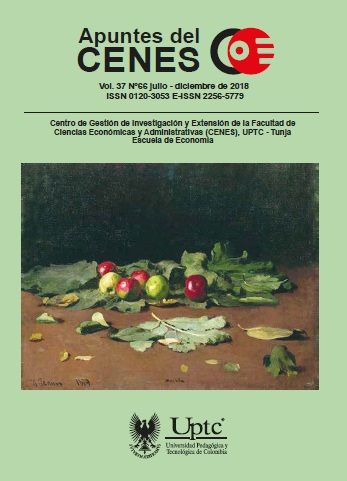Relationship between the Consumer Price Index and the Producer Price Index for Six South American Countries

Abstract
This paper analyzes the relationship between the consumer price index and the producer price index for six South American countries Brazil, Colombia, Ecuador, Peru, Paraguay and Uruguay. To determine this relationship we estimated an autoregressive vector model or a model of error correction vectors, depending on the level of integration of the two variables for each country. In addition, the impulse response analysis was performed, and the Toda and Yamamoto causality test was developed. The periodicity of the data varies for each country, as it depends on the availability of the information. Three VAR models (Brazil, Peru and Uruguay) and three VEC models were applied (Colombia, Ecuador and Paraguay) the estimated VAR models, is that in the impulse response function, after a shock of the CPI and / or the PPI on the other variable and on itself, the effects disappear in time and the variables return to their original values. In the VEC model on the other hand, after a shock of the CPI and / or the PPI on the other variable and on itself, the effects do not disappear in time, and therefore the variables present permanent changes in the time.
Keywords
autoregressive vector model, error correction vector model, unit root, cointegration, causality
Author Biography
Oscar Hernán Cerquera Losada
Programa de Economia
References
- Banco Central do Brasil (2016). Relatório de Inflação. Vol. 8. Num. 4. ISSN 1517-6576. Brasília.
- Bonilla, C. (2011). Economic structure and unemployment in Colombia: a VEC analysis. Sociedad and Economía. No. 20. 99-124.
- Bryan, F., Cecchetti, S. G. & Wiggins, R. (2011). Efficient Inflation Estimation. NBER Working Paper, (6183).
- Campos, C. & Jalil, M. (2000). Relación entre el índice de precios del productor (IPP) y el índice de precios al consumidor (IPC). Bogotá: Subgerencia de Estudios Económicos, Banco de la República. DOI: https://doi.org/10.32468/be.144
- Dickey, D. A., & Fuller, W. A. (1979). Distribution of the Estimators for Autoregressive Time Series With a Unit Root. Journal of the American Statistical Association, 74(366), 427-431. https://doi.org/10.1080/01621459.1979.10482531. DOI: https://doi.org/10.1080/01621459.1979.10482531
- Espinosa, O. A. and Vaca, P. A. (2015). The Influence of Financial, Fiscal and External Sectors in the Colombian Economy: A Bayesian VAR Approach. Desarrollo y Sociedad. No. 75. 11-49. DOI: https://doi.org/10.13043/dys.75.1
- Frimpong, J. M. and Oteng-Abayie, E. F. (2008). Bivariate Causality Analysis between FDI Inflows and Economic Growth in Ghana. International Research Journal of Finance & Economics. Vol. 15. 1-20.
- Granger, C. W. (1969). Investigaring Causal Relations by Econometric Model and Cross-spectral Method. Econometrica, 37(3), 424-438. https://doi.org/10.2307/1912791 DOI: https://doi.org/10.2307/1912791
- Hakimipoor, N. (2016). Investigation on Causality Relationship between Consumer Price Index and Producer Price Index in Iran. Iran: Hikari. DOI: https://doi.org/10.12988/ref.2016.51113
- Hannan, E. J., and B. G. Quinn (1979), The Determination of the order of an autoregression. Journal of the Royal Statistical Society, Series B, 41: 190–195. DOI: https://doi.org/10.1111/j.2517-6161.1979.tb01072.x
- Johansen, S., and Juselius, K., (1990). Maximum Likelihood Estimation and Inference on Cointegration– with Applications to the Demand for Money. Oxford Bulletin of Economics and Statistics, Vol. 52, No. 2, pp. 169–210. DOI: https://doi.org/10.1111/j.1468-0084.1990.mp52002003.x
- Loría, D. (2007). Econometría con Aplicaciones. Pearson Addison-Wesley Editor.
- Lütkepohl, H. (2004). Forecasting with VARMA Models. Economics Working Papers ECO2004/25, European University Institute.
- Martínez, W., Caicedo, E. & Tique, E. (2012). Explorando la relación entre el IPC e IPP: el caso colombiano. Bogotá: Borradores de Economía, Banco de la República.
- Mel, L. T. (2011). The Relationship Between Consumer Price Index (CPI) and Producer Price Index (PPI) in Malaysia. Masters thesis. Universiti Malaysia Sarawak, UNIMAS.
- OECD. (Abril de 2017). Data.OECD. Obtained from Data.OECD: https://data.oecd.org/price/producer-price-indices-ppi.htm.
- Schwarz, G. (1978). Estimating the dimension of a model. The Annals of Statistics. Vol. 6. No. 2. 461-464. DOI: https://doi.org/10.1214/aos/1176344136
- Selçuk A. (2011). The Causal Relationship between Producer Price Index and Consumer Price Index: Empirical Evidence from Selected European Countries. International Journal of Economics and Finance, 3(6), 227-232. DOI: https://doi.org/10.5539/ijef.v3n6p227
- Sims, C. (1972). Money, Income, and Causality. American Economic Review, 62(4), 540-552.
- Sims, C. A. (1980). Macroeconomics and Reality. Econometrica, 48(1), 1-48. https://doi.org/10.2307/1912017. DOI: https://doi.org/10.2307/1912017
- Toda, H. Y. and Tamamoto, T. (1995). Statistical inference in vector autoregressions with possibly integrated processes. Journal of Econometrics. Vol 66. 225-250. DOI: https://doi.org/10.1016/0304-4076(94)01616-8
